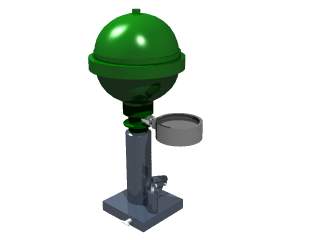Citroën ID/DS sphere testing
This page describes how to test the hydropneumatic spheres on the Citroën ID/DS models. The test procedure uses the DIY sphere tester as described elswere on this website.
 This page describes the general technique to test spheres. It can be done using the
sphere tester
described or using a special Citroën hydraulic components tester.
The sphere pressures
can be found on a seperate page.
This page describes the general technique to test spheres. It can be done using the
sphere tester
described or using a special Citroën hydraulic components tester.
The sphere pressures
can be found on a seperate page.
NOTE: Do not mix testing green and red hydraulic fluid spheres.
- Before starting measuring the sphere pressures make sure there is enough of the right hydraulic fluid in the sphere tester.
- Before placing the sphere on the tester check that the rubber sealing is in place.
- Tightning the sphere with your hands is more than sufficient to get a proper sealing. If not use a new rubber seal.
There are 4 basic conditions you can run into during testing a sphere;
- While increasing the pressure the reading stops between 0 and 10 bar. This means that the sphere has very low presure left. A refill of spheres below 10 bars is not advised, because the spheres membrane will most probably have already weak spots which might cause it to tear in the not to far future.
- When increasing pressure the gauge reading goes up and stops between 10 and 80 bars. This means the spheres membrane is ok, and the pressure can be checked against the required value for that type of sphere (see sphere pressures ).
- The gauge reading does not stop at the maximum value for the sphere but continues to increase. This means the membrane is most probably defective, and the sphere is filled up with hydraulic fluid. Don't stress your tester . Above 80 bars no sphere should operate. Increasing the pressure above that will put a heavy load on the construction of your tester.
- After every increase of pressure, pressure drops. This could be caused by a defective membrane leaking gas.
After testing release the hydraulic fluid pressure of your tester before taking the sphere off.
- www.schaalbouw.nl/citroen © 2014 E.Paijmans
-

-

-

-

-

-

-

-
